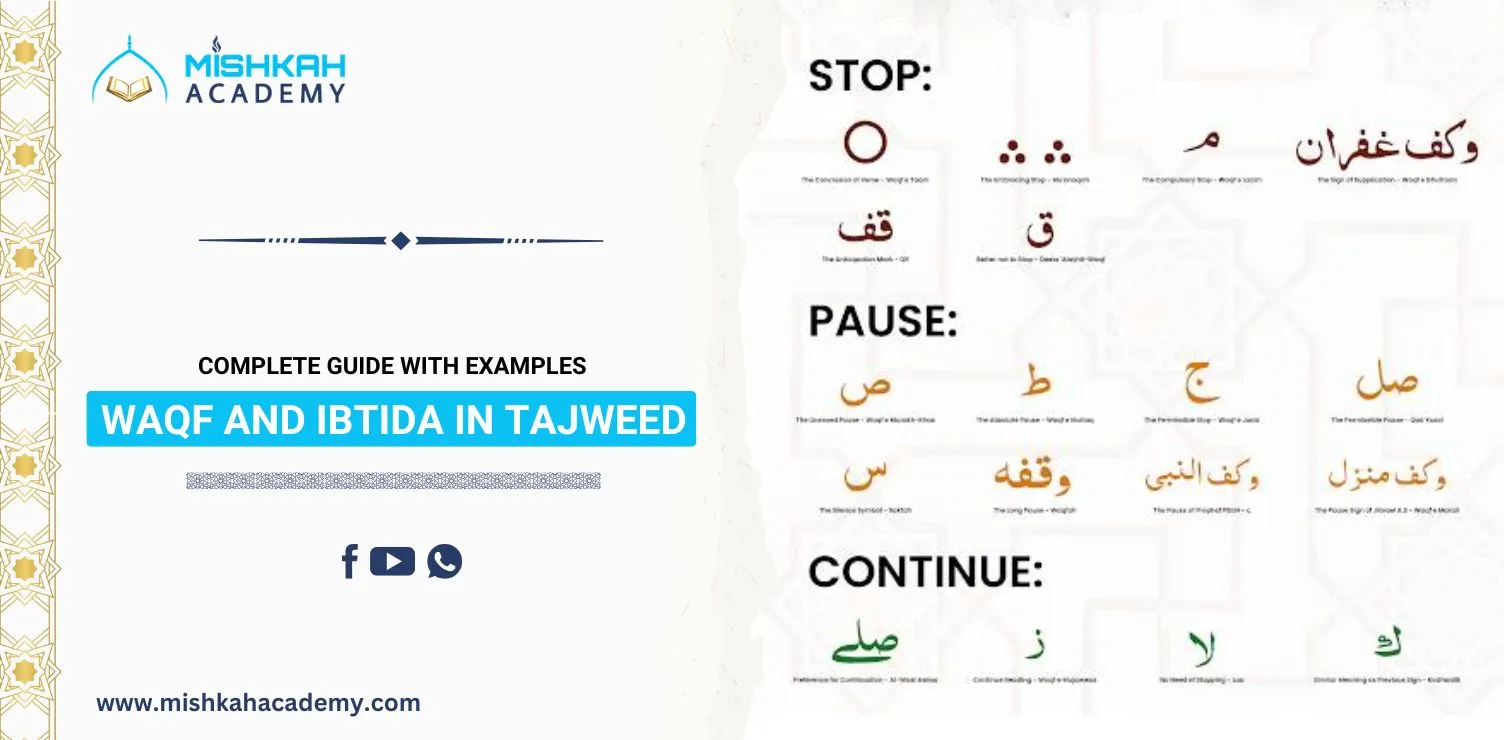Tajweed, the art of proper pronunciation and recitation of the Quran, is essential for anyone wishing to read the Quran accurately and beautifully. Among the many rules that govern Tajweed, Waqf (stopping) and Ibtida (beginning) are crucial concepts that enhance the clarity and understanding of the Quranic text. This article delves into the meanings, examples, types, symbols, and significance of Waqf and Ibtida in Tajweed.
This article delves into the definitions, rules, types, and examples of Waqf and Ibtida, highlighting their importance in Tajweed.
Understanding Waqf
Table of Contents
ToggleThe act of pausing or stopping when reciting the Quran is known as waqf (وقف). It is crucial for a number of reasons, such as maintaining grammatical rules, improving the listener’s understanding, and making meaning clear. When Waqf is used correctly, the reciter can effectively communicate the Quran’s meaning.
Waqf Types
Waqf comes in various forms, each with its own set of guidelines and meanings. The most widely recognized types are as follows:
1. Waqf Lazim (وقف لازم) is Required
To prevent changing the verse’s meaning, the reciter must end here. The following is an example from Surah Al-Muddathir (74:1) in the Quran:
“يَا أَيُّهَا الْمُدَّثِّرُ” (O you who is wrapped up [in a mantle]).
Stopping here is necessary to separate the address from the subsequent command.
2. Waqf Jaiz (وقف جائز)
This type of stop is permissible but not required. The reciter may choose to stop or continue based on their preference. An example can be found in Surah Al-Baqarah (2:256):
“لَا إِكْرَاهَ فِي الدِّينِ ۚ قَد تَّبَيَّنَ الرُّشْدُ مِنَ الْغَيِّ” (There is no compulsion in religion; the right course has become clear from the wrong).
Here, the reciter can choose to stop after “الدين” (religion) or continue to “الرشد” (the right course).
3. Waqf Muraqabah (وقف مرقبة)
This is a stop that allows for a short pause, and it is often used to emphasize the importance of what follows. An example can be found in Surah Al-Baqarah (2:2):
“ذَٰلِكَ الْكِتَابُ لَا رَيْبَ ۛ فِيهِ ۛ هُدًى لِّلْمُتَّقِينَ” (This is the Book about which there is no doubt, a guidance for those conscious of Allah).
Stopping after “فِيهِ” (in it) emphasizes the certainty of the Book’s guidance.
4. Waqf Muttasil (وقف متصل)
This is a connected stop where the reciter stops at a phrase that does not affect the overall meaning. An example can be found in Surah Al-Fatiha (1:1):
“بِسْمِ اللَّهِ الرَّحْمَـٰنِ الرَّحِيمِ” (In the name of Allah, the Most Gracious, the Most Merciful).
The reciter can stop after “الرَّحِيمِ” without disrupting the flow of the recitation.
Rules of Waqf
- Meaning Preservation: Preserving the verse’s meaning is the major Waqf regulation. Inappropriate stopping can cause miscommunications or incorrect readings of the words of the Quran.
- Clarity: When observing Waqf, the reciter should strive for clear pronunciation. The listener can understand the message when there is a definite halt.
- An acceptable pause: is one that lasts long enough for the listener to understand that a new concept or directive is being presented.
- Reciter’s Intent: The reciter needs to understand the purpose of every pause. Comprehending the verses’ context is necessary for proper Waqf.
Note: Furthermore more if you are unable to undersnat the rules of stopping when reading quran must get guidance from expert Quran tutors.
Start Your Tajweed Journey Today
Understanding Ibtida
Ibtida (ابتداء) is the term used to describe the continuation of recitation following a Waqf. It marks the start of a new sentence or idea in the recitation. Being proficient in Ibtida guarantees a seamless flow from one verse or phrase to the next, preserving the recitation’s coherence.
Ibtida Types
- Ibtida Lazim (ابتداء لازم): This is a necessary start that denotes a novel concept or notion. To prevent misunderstandings, the reciter must state the new verse properly.
- Ibtida Jaiz (ابتداء جائز): It is possible to choose where to begin with Ibtida Jaiz (ابتداء جائز). Depending on their inclination, the reciter may start from any point in a verse.
- Ibtida Muraqabah (ابتداء مرقبة): Like Waqf Muraqabah, Ibtida Muraqabah (ابتداء مرقبة) highlights the significance of what comes next. After pausing, the reciter begins a noteworthy verse.
Ibtida’s rules
- Waqf Consistency: The recitation must be consistent with the Waqf that was previously observed. This implies that the meaning needs to stay consistent and whole.
- Pronunciation: To keep the recitation’s rhythm and flow, the reciter must make sure they pronounce the new phrase’s first letter correctly.
- Context Awareness: It’s important to comprehend the context of the passage being resumed. The new verse’s relationship to the following one should be clear to the reciter.
Waqf and Ibtida Signs & Symbols
The Quran uses specific symbols to indicate Waqf and Ibtida, guiding readers on how to recite properly:
- م (Waqf Lazim): Indicates a necessary stop.
- لا (Waqf Jaiz): Indicates that stopping is not recommended but allowed.
- ط (Waqf Murakhkhas): Indicates a preferred stop for better understanding.
- قلي (Waqf Mutlaq): Indicates an absolute stop.
These Waqf Symbols are crucial for anyone studying Tajweed, as they ensure that Quran recitation follows the correct rules and enhances comprehension of the Quran’s message.
Note: Enroll in the Advance tajweed course to learn Waqf And Ibtida with expert egyptian quran tutors.
Start Your Tajweed Journey Today

Examples of Waqf From the Quran
1. Waqf Lazim (Mandatory Stop)
Surah Al-Muddathir (74:1):
“يَا أَيُّهَا الْمُدَّثِّرُ”
(O you who is wrapped up [in a mantle])
Explanation: A mandatory stop is needed here to separate the address from the command that follows. Stopping here maintains clarity.
2. Waqf Jaiz (Permissible Stop)
Surah Al-Baqarah (2:256):
“لَا إِكْرَاهَ فِي الدِّينِ ۚ قَد تَّبَيَّنَ الرُّشْدُ مِنَ الْغَيِّ”
(There is no compulsion in religion; the right course has become clear from the wrong)
Explanation: The reciter may choose to stop after “الدين” (religion) or continue to “الرشد” (the right course), as both options are grammatically and contextually valid.
3. Waqf Muraqabah (Connected Stop)
Surah Al-Fatiha (1:2)
“الْحَمْدُ لِلَّهِ رَبِّ الْعَالَمِينَ”
(All praise is [due] to Allah, Lord of the worlds)
Explanation: Stopping here emphasizes the importance of acknowledging Allah as the Lord of all worlds before continuing to describe His attributes.
4. Waqf Muqafaf (Flexible Stop)
Surah Al-Mulk (67:1):
“تَبَارَكَ الَّذِي بِيَدِهِ الْمُلْكُ”
(Blessed is He in whose hand is the dominion)
Explanation: The reciter can stop after “الْمُلْكُ” without disrupting the flow, allowing for a smooth transition into the next phrase.
5. Waqf Muttasil (Connected Stop)
Surah Al-Fatiha (1:7):
“صِرَاطَ الَّذِينَ أَنْعَمْتَ عَلَيْهِمْ”
(The path of those upon whom You have bestowed favor)
○ Explanation: The reciter may choose to stop here, and it does not hinder the flow of the message, as it clearly leads into the next part.
Examples of Ibtida From Quran
1. Ibtida Lazim (Mandatory Beginning)
Surah Al-Mulk (67:2):
“الَّذِي خَلَقَ الْمَوْتَ وَالْحَيَاةَ”
(Who created death and life)
Explanation: After stopping, the reciter must clearly articulate the next verse to emphasize the new idea of testing people through their deeds.
2. Ibtida Jaiz (Permissible Beginning)
Surah Al-Baqarah (2:2)
“ذَٰلِكَ الْكِتَابُ لَا رَيْبَ فِيهِ”
(This is the Book about which there is no doubt)
Explanation: The reciter has the choice to begin from various points in this verse, demonstrating flexibility based on context and preference.
3. Ibtida Muraqabah (Emphasized Beginning)
Surah Al-Baqarah (2:256)
“قَد تَّبَيَّنَ الرُّشْدُ مِنَ الْغَيِّ”
(The right course has become clear from the wrong)
Explanation: After pausing at “الرشد” (the right course), the reciter resumes to emphasize the distinction between right and wrong.
4. Ibtida Muqafaf (Flexible Beginning)
Surah Al-Fatiha (1:6)
“اهْدِنَا الصِّرَاطَ الْمُسْتَقِيمَ”
(Guide us to the straight path)
Explanation: The reciter may start from this point after a pause, emphasizing the request for guidance without losing the essence of the prayer.
5. Ibtida Mutassil (Connected Beginning)
Surah Al-Baqarah (2:3):
“الَّذِينَ يُؤْمِنُونَ بِالْغَيْبِ”
(Who believe in the unseen)
Explanation: Following a Waqf, the reciter clearly articulates this beginning, indicating a new concept while maintaining the coherence of the message.
Start Your Tajweed Journey Today
Importance of Learning the Tajweed Rules of Waqf and Ibtida
The correct recitation of the Quran is essential for understanding and preserving its meaning, and the rules of Waqf (stopping) and Ibtida (starting) play a significant role in this. Mastering these rules ensures that the reciter maintains the integrity of the Quranic message. Below are key reasons why learning these Tajweed rules is so important:
1. Preserving the Correct Meaning of the Quran
Incorrectly stopping (Waqf) or starting (Ibtida) at the wrong place can change the intended meaning of the Quranic text.
Example: Stopping prematurely at the phrase “Lā ilāha” (لا إله) changes the message from “There is no god except Allah” (لا إله إلا الله) to “There is no god,” which is incorrect and misleading.
2. Enhancing Focus and Clarity in Recitation
- The rules of Waqf help the reciter take meaningful pauses, improving the flow and clarity of recitation.
- Knowing where to stop avoids the disruption of thought, helping listeners understand and reflect on the message being conveyed.
3. Maintaining the Sunnah of Proper Quranic Recitation
Following the rules of Waqf and Ibtida is by the tradition of the Prophet Muhammad (PBUH), who recited the Quran with measured pauses (Tarteel). Allah commands in the Quran:
“And recite the Quran with measured recitation.” (Surah Al-Muzzammil 73:4)
4. Avoiding Errors (Lahn) in Recitation
- A lack of knowledge about where to stop or begin can lead to Lahn (mistakes), which may alter the meaning or create ambiguity.
- Learning these rules ensures that reciters can avoid both major (Lahn Jali) and minor (Lahn Khafi) mistakes.
5. Facilitating Reflection (Tadabbur) on Quranic Verses
- Waqf allows time for the reciter and the listeners to pause, reflect, and absorb the meanings of the verses.
- Ibtida helps ensure that when the recitation resumes, it starts at an appropriate point that aligns with the message of the verse.
6. Building Confidence in Recitation
- Knowing when to pause and where to begin gives the reciter more confidence, especially when reciting aloud in prayer or in public settings.
- It also improves fluency, as the reciter becomes aware of logical places for breaks, reducing hesitation.
7. Following the Guidance of Scholars and Mushafs
- The Quranic script contains Waqf signs (like م, لا, ط, ص, and more) to guide reciters, based on scholarly consensus and traditions.
- Learning these rules ensures that one can use these signs correctly and understand the nuances of their application.
The Tajweed rules of Waqf and Ibtida are essential for preserving the accuracy and beauty of Quranic recitation. They ensure the meaning of the Quran is conveyed without distortion, following the example of the Prophet (PBUH).
For those looking to deepen their understanding of Waqf And Ibtida aspects of Qur’anic recitation, enrolling in an online Tajweed course can be highly beneficial. This structured learning approach helps to master the rules of Tajweed, including all the proper rules of pause and starting to improves one’s recitation accuracy.






